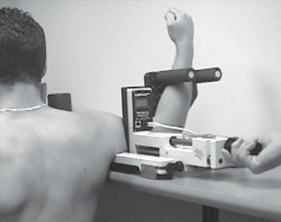|
PRACTICAL
SIGNIFICANCE
The
throwing
shoulders
of
active
collegiate
baseball
pitchers
do not
exhibit
clinically
significant
acute
alterations
in
glenohumeral
joint
laxity
and
stiffness,
posterior
shoulder
tightness,
or
scapular
upward
rotation
at rest
or
following
a
bullpen
throwing
session.
However,
chronic
alterations
in
rotational
range of
motion
(ROM) is
present
with a
near
symmetric
gain in
throwing
shoulder
external
rotation
and loss
of
internal
rotation
of
approximately
10° that
does not
change
significantly
following
pitching.
Therefore,
alterations
in these
shoulder
mobility
variables
may be
early
warning
signs
for the
development
of
shoulder
pathology.
STUDY
BACKGROUND
Four
common
factors
have
been
attributed
to the
pathologic
throwing
shoulder:
1)
increased
anterior
humeral
translation,
2)
increased
posterior
shoulder
tightness,
4)
internal
rotation
deficit
that
exceeds
external
rotation
gain,
and 5)
loss of
scapular
upward
rotation.
Limited
data are
available
regarding
the
chronic
adaptations
in
shoulder
mobility
that
occurs
as a
result
of
repetitive
overhead
throwing.
Even
fewer
data are
available
that
have
examined
the
acute
effects
of
throwing
on
shoulder
mobility.
In the
absence
of
baseline
information
regarding
shoulder
mobility
adaptations
in
baseball
pitchers,
it is
difficult
to
determine
their
possible
contribution
towards
the
development
of
shoulder
pathology.
OBJECTIVE
To
evaluate
glenohumeral
(GH)
joint
and
scapular
kinematics
in
collegiate
baseball
pitchers
at rest
and
after a
pitching
sequence
to
evaluate
the
acute
and
chronic
effects
of
throwing
on
shoulder
girdle
mobility.
DESIGN
AND
SETTING
A
repeated
measures
design
was used
to
assess
shoulder
mobility
variables
prior to
and
following
a
pitching
session
at
collegiate
baseball
facilities.
SUBJECTS
Forty-four
asymptomatic
collegiate
baseball
pitchers
(age =
19.2 ±
1.0
years,
height =
184.9 ±
5.1 cm,
mass =
82.7 ±
8.2 kg,
years
pitching
= 8.5 ±
3.9)
from a
sample
of
convenience
participated
in this
study.
MEASUREMENTS
The
following
dependent
variables
were
measured:
1) GH
joint
laxity
(mm), 2)
GH joint
stiffness
(N/mm),
3)
Posterior
shoulder
tightness
{(PST)
cm} 4)
External
rotation
(ER), 5)
Internal
rotation
(IR),
and 6)
Scapular
upward
rotation
(SUR).
Shoulder
mobility
measures
were
obtained
bilaterally
prior to
any
activity
and
again
after
throwing
a
bullpen
session.
GH
laxity
and
stiffness
were
measured
using a
LigMaster™
computerized-stress
arthrometer
(Figure
1), PST
was
measured
using a
carpenters
square,
ER and
IR were
measured
using a
goniometer,
and SUR
was
measured
using a
digital
inclinometer
(Figure
2).
Separate
2(side)
x
3[position
(anterior-neutral,
anteriorninety,
posterior-neutral)]
x
2(session)
repeated
measures
ANOVAs
were
used to
assess
laxity
and
stiffness.
Separate
2(side)
x
2(session)
repeated
measures
ANOVAs
were
performed
to
evaluate
PST, ER,
and IR.
A 2
(side) x
2(session)
x 4
(elevation
angle)
repeated
measures
ANOVA
was
utilized
to
examine
SUR.
RESULTS
Pitchers
threw an
average
of 50.2
±10.8
(range
30-75)
pitches.
No
significant
main
effect
for
laxity
was
observed
for side
(P=0.051)
or
session
(P=0.096),
but a
significant
main
effect
for
position
was
observed
(P<.001).
The side
x
session
x
position
interaction
for
laxity
was
nonsignificant
(P=0.75).
A
significant
main
effect
for
stiffness
was
observed
for side
(P=0.044),
session
(P=0.002),
and
position
(P<.001).
The
stiffness
side x
session
x
position
interaction
was
non-significant
(P=0.91).
For PST,
the main
effect
for side
(P=0.77)
and the
side x
session
interaction
(P=0.12)
were
nonsignificant.
A
significant
difference
between
sides
was
observed
for ER
(throwing
= 105.1
± 8.7°,
non-throwing
= 93.8 ±
8.8°;
P<.001).
However,
the side
x
session
interaction
for ER
was
non-significant
(P=0.84).
A main
effect
for side
was
observed
for IR
(throwing
=44 ±
8.3°,
non-throwing
= 54.8 ±
8.6°;
P<.001).
The side
x
session
interaction
for IR
was
nonsignificant
(P=0.54).
For SUR,
the main
effect
for side
(P=0.62)
and the
side x
session
x
elevation
angle
interaction
(P=0.26)
were
non-significant.
CONCLUSIONS
Collegiate
baseball
pitchers
demonstrated
no
significant
chronic
or acute
adaptations
in
glenohumeral
laxity,
PST, or
SUR.
A
statistically
significant,
but
clinically
small
(<1
N/mm),
chronic
adaptation
in
glenohumeral
stiffness
was
observed
with no
significant
acute
differences.
Statistically
and
clinically
significant
chronic
adaptations
in ER
and IR
were
present
(≥9°),
but no
acute
differences
were
observed
as a
result
pitching
a
bullpen
session.
|

Figure 1 |

Figure 2 |
|
Publication
&
Presentation
List:
-
Sauers EL, Johnson MP, Tafoya J, Boquiren M. The acute and chronic effects of throwing on shoulder mobility in collegiate baseball pitchers. 2007. NATA Annual Meeting and Clinical Symposium. Anaheim, CA.
-
Crawford SD, Sauers EL. Glenohumeral joint laxity and stiffness in the functional throwing position of high school baseball pitchers. Journal of Athletic Training. 2006;41(1):36-43.
-
Sauers EL, Crawford SD, Valovich McLeod TM. Reliability of the LigMaster™ computerized-stress device for measuring glenohumeral joint laxity and stiffness in baseball pitchers. Journal of Athletic Training. 2005;40(2):S-21.
-
Crawford SD, Sauers EL. High school baseball pitchers demonstrate side-to-side symmetry in glenohumeral joint laxity and stiffness. Journal of Athletic Training. 2005;40(2):S-21.
|
|
|
|

Eric L. Sauers, PhD, ATC, CSCS
Principal Investigator
|
Eric L. Sauers, PhD in Sports Medicine, Oregon State University. Currently, Dr. Sauers is an Associate Professor/Director of the Athletic Training Program and serves as Chair of the Department of Interdisciplinary Health Sciences at the Arizona School of Health Sciences (ASHS), A. T. Still University, Mesa, Arizona. Dr. Sauers primary research interests are related to examination and rehabilitation of the athletic shoulder with specific interests in shoulder outcomes assessment, the effectiveness of interventions for treating shoulder impairment, and throwing shoulder mobility assessment. He has served as a research consultant to the Chicago Cubs baseball organization and is a Member-at-Large of the American Society of Shoulder and Elbow Therapists.
Eric L. Sauers, PhD, ATC, CSCS
Arizona School of Health Sciences
5850 E. Still Circle
Mesam AZ 85206
Phone: 480-219-6000
E-mail: esauers@atsu.edu
|
|
|
This
Grant
Information
Summary
may be
downloaded
in a
2-page
pdf file
from
http://www.natafoundation.org/PDF/07Sauers.pdf |
Back to
May 16, 2012
eBlast
Newsletter
Send e-mail
to rachaelo@nata.org with questions
or
comments
about this web site. |


